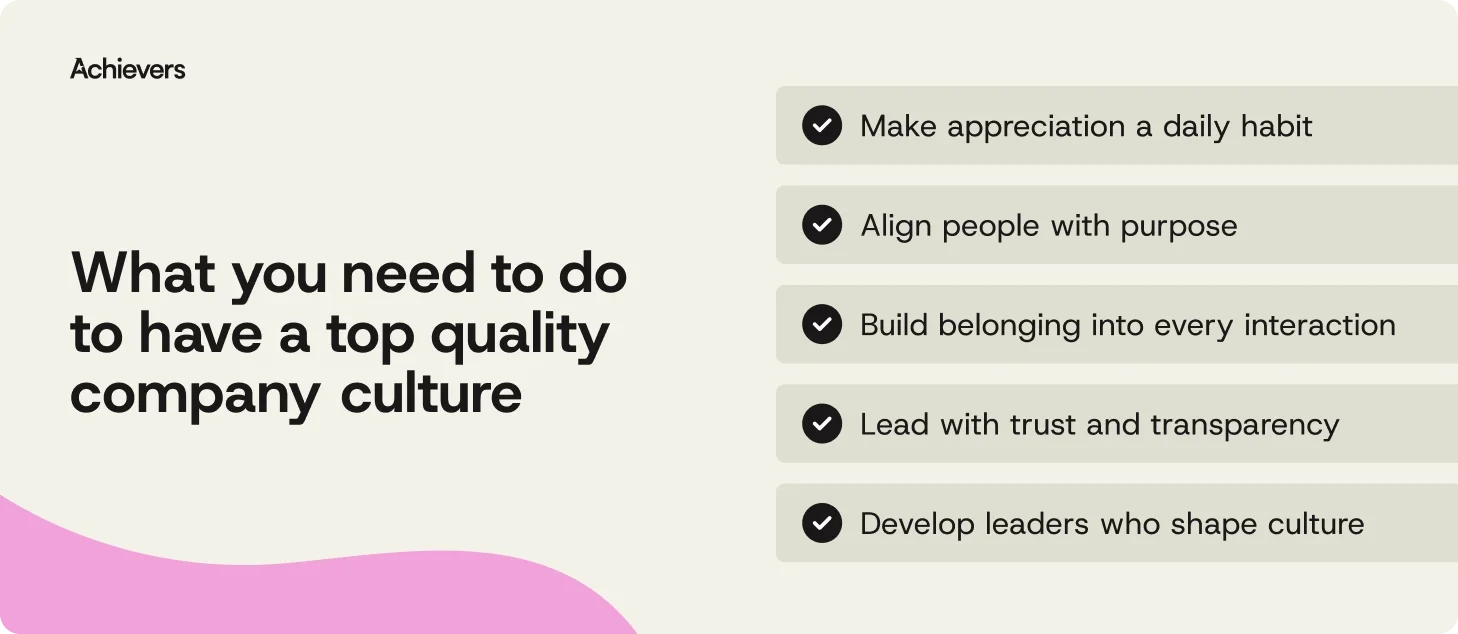Table of contents
Ask any business leader the secret to lasting success and you’ll hear plenty of answers. But one factor quietly drives it all: company culture. Not the fluffy posters or free pizza days — the real culture. The values, behaviors, and everyday experiences that shape how people show up, do their best work, and drive results.
And it’s no small thing. According to a survey of 500 global CEOs, 71% rank culture as a top driver of financial performance — up from just 26% a few years ago. Turns out, a thriving culture doesn’t just make people happier — it makes businesses stronger, faster, and more resilient.
In this guide, we’ll unpack what culture really means, why it’s a direct line to better business outcomes, and how you can shape a culture that attracts talent, powers performance, and makes Monday mornings a little less painful. Let’s get into it.
Why company culture matters now more than ever
In a world where job hopping is practically a sport, one thing keeps people sticking around: feeling valued. Recognition isn’t just a nice-to-have — it’s fuel for engagement, loyalty, and performance. Employees who are regularly recognized aren’t just happier, they’re less likely to be dusting off their resumes. Turns out, appreciation goes a long way — and not just in the paycheck.
Now, with remote and hybrid work reshaping how teams connect, culture matters more than ever. Without the hallway chats and impromptu coffee runs, companies need to be deliberate about building connection, driving collaboration, and reinforcing shared values. A thriving culture isn’t tied to an office — it’s what keeps people motivated and moving in the right direction, no matter where they log in.
How to spot a healthy (or not-so-healthy) company culture
Company culture isn’t just about feel-good vibes — it’s a direct line to employee engagement, productivity, and retention. And like most things, it leaves behind some pretty obvious clues. Here’s what to watch for:
Green flags: Signs you’re getting it right
- People speak up (and get listened to): Employees feel safe sharing ideas and feedback — no fear, no eye rolls.
- Recognition happens early and often: Great work doesn’t go unnoticed or unappreciated.
- Leaders communicate clearly: There’s honesty, openness, and room for real conversations.
- There’s purpose beyond profit: Employees know their work matters and feel connected to the bigger picture.
- Growth is part of the deal: People have real opportunities to learn, grow, and advance — no career dead-ends here.
Red flags: Warning signs it’s time for a culture check
- A revolving door of talent: High employee turnover signals people are voting with their feet.
- Disengagement is in the air: You’ll notice the energy dip when employees are checked out.
- Leaders go radio silent: Poor transparency leaves people guessing — and guessing rarely ends well.
- Tension you can cut with a knife: Favoritism, cliques, and toxic behavior make work… well, work.
- Feedback falls on deaf ears: When employee voices are ignored, frustration tends to stick around longer than the people do.
Top 5 building blocks of an exceptional culture
Great culture doesn’t just sprout up like moss on a shady rock. It’s intentional. It’s built. And when done right, it becomes the foundation of employee retention, engagement, and results. Here are five culture cornerstones that separate thriving workplaces from the rest:

1. Make appreciation a daily habit
When people feel appreciated, they do better — and they stick around longer. Employee recognition shouldn’t be a quarterly “nice-to-have.” It should be an everyday reflex. Whether it’s a shoutout from a teammate or a company-wide celebration, regular recognition helps employees feel seen, heard, and valued. That’s what keeps morale high and performance higher.
2. Align people with purpose
When employees understand how their work ladders up to something bigger, magic happens. (Okay, not actual magic — more like clear goals, steady communication, and purpose-driven action.) Cultural alignment happens when everyone’s rowing in the same direction and no one’s stuck paddling in circles.
3. Build belonging into every interaction
Culture isn’t culture if people feel like outsiders. A sense of belonging is what turns a group of coworkers into a community. And no, it’s not just about potlucks and team-building retreats — it’s about creating a workplace where every voice matters, and every person knows they have a place (and a future) here.
4. Lead with trust and transparency
Without trust, everything wobbles. People need to believe in their leaders, their teams, and the mission they’re showing up for. That means transparent communication, following through on promises, and creating space for honest feedback. Bonus: Trust also happens to be a pretty good breeding ground for innovation.
5. Develop leaders who shape culture
Managers aren’t just taskmasters — they’re culture shapers. A good leader doesn’t just manage work; they model behavior, build confidence, and inspire action. And when leaders lead with empathy and integrity? That’s when culture goes from good to exceptional. Invest in your leaders, and your culture will follow.
How to build (and actually keep) a positive company culture
A thriving culture doesn’t just happen — it’s built with purpose and maintained with care. Companies that get it right see higher engagement, lower turnover, and the kind of business results spreadsheets love. Here’s how to shape a culture people actually want to be part of:
- Start with values that mean something: Skip the corporate jargon and define company values that guide real decisions — not just decorate the breakroom wall.
- Make recognition part of the everyday: Appreciation should be frequent, genuine, and easy. (Pro tip: Achievers makes that part a breeze.)
- Create a culture of belonging: Build inclusivity through DEI initiatives, diverse hiring practices, and employee resource groups — because people thrive when they feel like they belong.
- Invest in the whole employee experience: From professional growth to flexibility to well-being, give employees the tools and space to succeed — inside and outside of work.
- Use tech to keep the momentum going: Hybrid and remote teams need culture too. The right technology (like Achievers) helps you stay connected and engaged — no matter where people work.
Strong culture isn’t a one-and-done project. It’s a habit. And with the right approach, it’s one that pays off every single day.
Here’s your rewritten section, tailored to the Achievers tone and voice — clear, simple, professional, understanding, optimistic, honest, and with a little wry edge:
How to measure (and actually improve) company culture
You can’t fix what you don’t measure — and company culture is no exception. To really understand how culture is landing with your people (and impacting your business), it pays to track the right signals and take action. Here are some HR metrics to start with:
- Employee Net Promoter Score (eNPS): The ultimate gut check. Are employees recommending your company to others? High eNPS = happy, engaged people. Low eNPS = time to dig deeper.
- Engagement surveys: Regular pulse surveys take the guesswork out of employee sentiment. They show you what’s working and where things need a little TLC.
- Retention and turnover rates: High turnover usually means trouble. Solid retention? That’s a sign your culture’s doing its job.
- Recognition participation rates: If people are recognizing each other often, you’ve built a culture of appreciation. If not…well, that’s a red flag waving at you.
The takeaway? Culture isn’t a “set it and forget it” scenario. Keep listening, keep measuring, and keep improving. Your employees (and your bottom line) will thank you.
How HR can keep culture healthy (without the guesswork)
Great culture doesn’t run on autopilot. It takes regular check-ins, honest listening, and a willingness to tweak things when needed. Here’s how HR teams can keep culture on track:
- Listen up — and often: Surveys, one-on-ones, focus groups… whatever works to hear directly from employees. Because “we think things are fine” isn’t the same as knowing they are.
- Use data to stay sharp: Platforms like Achievers help HR track culture in real time — spotting trends before they turn into problems.
- Close the loop: Feedback without action just builds frustration. Share the results, be honest about what’s changing, and follow through.
- Lead by example: Culture starts at the top. When leaders live the company values — and recognize others for doing the same — it sticks.
Good organizational culture is never finished. But with the right tools and habits, it keeps getting stronger.
Stronger culture = stronger business
Here’s the simple truth: when your culture thrives, your business follows. The best-run organizations know that culture isn’t window dressing — it’s the engine driving engagement, retention, and performance.
Great cultures are built on appreciation, alignment, belonging, and trust. But they don’t stay strong by accident. The smartest leaders measure often (think eNPS, pulse surveys, retention rates) and adjust as they go. Because ignoring culture is like ignoring the check engine light — eventually, it costs you.
Want to build a culture people rave about? Start by defining clear values, fostering inclusion, investing in people, and using the right tools to keep engagement high — especially when teams are working from anywhere. With Achievers, recognition and feedback flow naturally, helping employees feel valued, connected, and motivated.
Bottom line: great culture drives great results. So, listen to your people, act on what you hear, and build a workplace where everyone — and your business — can thrive.



